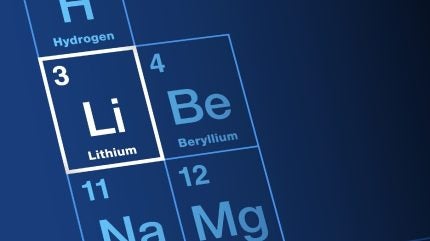
Often linked to electric vehicles (EVs) and energy storage, lithium’s significance in the energy transition is unquestionable. But beyond its starring role in batteries, the critical mineral is emerging as a linchpin in advanced nuclear technology.
Several advanced nuclear technologies require lithium-6 (Li-6) and lithium-7 (Li-7), products of lithium isotope separation (or enrichment), achieved through methods such as the column exchange (COLEX) process.

Discover B2B Marketing That Performs
Combine business intelligence and editorial excellence to reach engaged professionals across 36 leading media platforms.
Li-6 is essential for breeding tritium, one of the fuels in nuclear fusion. Li-7 plays a crucial role in advanced fission systems such as molten salt reactors (MSRs), enhancing safety and efficient heat transfer. Li-7 is also added to the coolant in traditional pressurised water reactors (PWRs) – currently the most common reactor type globally – to maintain proper pH and prevent corrosion. For both these applications, the Li-7 must be very pure to prevent tritium formation by neutron capture.
“Enriched lithium is foundational to next-generation nuclear energy,” says Charlie Jarrott, CEO and co-founder of US isotope enrichment technology start-up Hexium.
It is fair to challenge the urgency of securing enriched lithium supply, especially when many advanced nuclear technologies still face other significant hurdles to becoming commercially viable. However, the industry continues to move forward despite doubts, and the question of fuel supply cannot wait until those systems are ready. If the promise of fully commercial advanced nuclear is to be realised, the work to lay the groundwork must begin now.
From arms race to green race: why lithium enrichment is back in the spotlight
Once a niche concern of nuclear weapons programmes, lithium isotope separation is back in the spotlight – driven not by bombs but by breakthroughs in nuclear energy.

US Tariffs are shifting - will you react or anticipate?
Don’t let policy changes catch you off guard. Stay proactive with real-time data and expert analysis.
By GlobalDataThe advanced nuclear power sector is expanding rapidly across the world.
Nuclear fusion saw a historic surge in deal-making in 2022, worth $133bn, according to Power Technology’s parent company GlobalData. Since the record-breaking year, the industry has shown no signs of slowing down, reinforcing the persisting appetite for fusion. In 2024, supply chain spending by fusion companies nearly doubled to $434m from around $250m in 2023.
Governments supporting research and development in fusion and its supply chain, such as France hosting the international International Thermonuclear Experimental Reactor (ITER) project, also showcase clear market signals for the technology.
Meanwhile, MSRs have also continued to gain traction, with China, the US and Canada leading the way.
“China is actively advancing its expertise in MSR technology, with a particular focus on reactors that utilise thorium as a fuel source,” says GlobalData energy analyst Rehaan Aleem Shiledar. The Asian nation has achieved successful operation with its two megawatt-thermal experimental reactor in the Gobi Desert and has set forth plans to construct an expanded 10MW demonstration reactor by 2030.
In the US, various organisations are working toward development of MSRs, including Idaho National Laboratory’s cutting-edge test loop for the world’s first fast-spectrum, salt-fuelled reactor experiment and Terrestrial Energy’s small modular nuclear plant that utilises its proprietary Generation IV Integral Molten Salt Reactor technology.
The Canadian Government has invested approximately C$50.5m ($40.5m) in Moltex Energy, “a strategic investment that positions the country to potentially operate the world’s inaugural MSR by the early 2030s”, says Shiledar. GlobalData projects that MSRs could represent 14% of Canada’s nuclear reactor fleet by 2035.
As these technologies move from theoretical to tangible, their appetite for enriched lithium is growing.
According to the World Nuclear Association (WNA), global demand for Li-7 currently stands at around one tonne (t) per year for PWRs, but this is estimated to increase to 250t per year once MSRs commercialise, with tens of tonnes required for each reactor.
Lithium-6 demand is also expected to spike alongside developments in fusion, with Richard J. Pearson, co-founder and chief innovator at Kyoto Fusioneering, projecting fusion pilot plants will require Li-6 enrichment quantities in the order of tens of tonnes, then hundreds of tonnes for commercial fusion.
Yet, supply security and innovation in lithium enrichment has lagged behind this projected demand.
Historically, lithium isotope separation was the domain of weapons programmes, with countries including the US, Russia and China enriching Li-6 for thermonuclear weapons. Most nations have since dropped enrichment efforts, mainly due to concerns over mercury contamination from the COLEX process.
Today, only Russia and China actively produce both Li-6 and Li-7 (although China is allegedly just buying from Russia), according to the WNA. This supply, however, is not known to be available for nuclear development elsewhere.
The only commercially available source of tritium for fusion programmes across the world is a by-product of CANada Deuterium Uranium reactors, quantities of which are relatively small and thus insufficient to fuel commercial fusion. Meanwhile, fusion research in the US has reportedly relied on a limited stockpile from its Oak Ridge National Laboratory. Concerns around tritium supply are exacerbated by its relatively short half-life of 12.33 years, which means it takes just over a decade to decay to half of its original amount.
The lopsided enriched lithium production landscape poses risks, especially for countries like the US that are aiming to ramp up advanced nuclear energy programmes but lack enrichment capabilities. This challenge is compounded by growing tensions between the US and the very countries capable of supplying these critical isotopes.
Adding to concerns is that the COLEX process – currently the only method able to enrich lithium at industrial scale – comes with major environmental baggage, highlighting the need for progress in not only supply but also innovation.
Promising alternatives like electrochemical migration, laser isotope separation and crown ether-based methods have been in development. Most recently, UK fusion company Astral made a breakthrough, becoming the first to produce tritium through its own multi-state fusion reactor.
However, such efforts remain largely experimental and underfunded.
The US wants back in: developing a domestic supply chain
The global momentum behind nuclear energy is clear, and the US is no exception. The ADVANCE Act, signed into law in 2024, laid the groundwork for regulatory reform and funding support for advanced nuclear technologies. More recently, President Trump issued an executive order calling for a “nuclear energy renaissance”.
Michael Palank, general partner at MaC Venture Capital (VC), a firm building a clean energy portfolio focused on “re-industrialisation and supply chain autonomy”, and one of Hexium’s investors, believes that fusion in particular is the key to the US’ energy-secure future.

“Nuclear fusion shows potential to become the ultimate form of abundant, cheap and clean energy. Thus, countries that master commercial fusion stand to be the wealthiest and most influential countries in the world for a long time to come, and it is essential that the US is one of those countries,” he says.
However, enthusiasm alone won’t fuel the future. Without a strong and reliable domestic supply chain, advanced nuclear technologies “cannot scale”, says Jarott.
“Yet, the US remains critically dependent on foreign suppliers for these materials,” he explains.
“Dependence on geopolitical rivals for critical isotopes creates strategic and economic risks. It threatens the stability of nuclear energy supply chains and undermines national security objectives tied to energy independence.”
Now, the US and other government entities such as the UK Atomic Energy Authority are racing against the clock and global competition to rebuild lithium isotope separation capabilities.
“We are already seeing momentum in the form of policy shifts, investment and private sector initiatives to onshore isotope production,” says Jarott, whose company recently secured $12m in funding to advance atomic vapour laser isotope separation (AVLIS) technology for lithium enrichment – a technology that has historically “focused on uranium enrichment”.
He believes that “with technologies like AVLIS, the US can substantially reduce foreign reliance for lithium isotopes within 3–5 years”.
However, he and Palank note that further support to develop domestic lithium enrichment capabilities remains “extremely urgent”, and “now is the time” to accelerate progress as “both the technology and market are aligned”.
“Advances in lithium isotope separation technology, coupled with urgent demand for clean energy and national security, make this the right time to re-establish US leadership in isotope production,” Jarott elaborates.
Palank agrees: “Only recently have we seen the market signals and geopolitical landscape align to make domestic lithium enrichment commercially possible… we are now preparing for a new era of urgency and demand for lithium isotopes.”
The race to the finish line
For advanced nuclear ambitions to become reality, there are a host of challenges that still need to be addressed, including “securing supply of enriched uranium, reducing costs of developing reactors and technologically innovating across industrial automation, design and power infrastructure”, says Palank. Amid these priorities, lithium enrichment has largely remained on the backburner – but it is time to bring it forward.
While commercial fusion and MSRs may still be in the distance, governments and private investors alike are beginning to recognise that if demand from fusion and advanced fission grows exponentially and simultaneously, the world could face a supply crunch unlike any it has seen.
Building a secure supply of enriched lithium is about future-proofing the clean energy transition. As per Jarott, “isotopes are essential to unlocking a safer, cleaner and more efficient nuclear future. Without a reliable domestic supply, the ambitious road maps of fusion and fission developers are not achievable.”
“The nice part about investing in lithium isotope producers now is that while demand for Li-6 for commercial fusion operations may be one or two decades away, there are still several well-funded fusion companies today that have rather large demand for Li-6 for use in their experimental reactors,” Palank adds.
Indeed, the EU reported that the ITER test blanket module required approximately 200kg of enriched lithium, while estimations for the DEMO reactor are predicted to require more than 60t/GW, declaring it “unclear whether sufficient Li-6 will be available”.
Palank thus recognises opportunity in getting a head start. “Given demand for just experimental fusion reactors, we feel there is a path for lithium enrichers to get to several hundred million in revenue now, and when commercial fusion becomes reality, reach the billions,” he states.
“Isotope enrichment will be a cornerstone of the clean energy transition,” Jarott concludes. “As fusion matures and advanced fission reactors deploy, demand for specialised isotopes will surge, not just for lithium but others critical to energy, space and medicine.
“In 5–10 years, I see isotope enrichment moving from a niche capability to a strategic industry, underpinning energy independence, technological leadership and decarbonisation efforts globally.”





